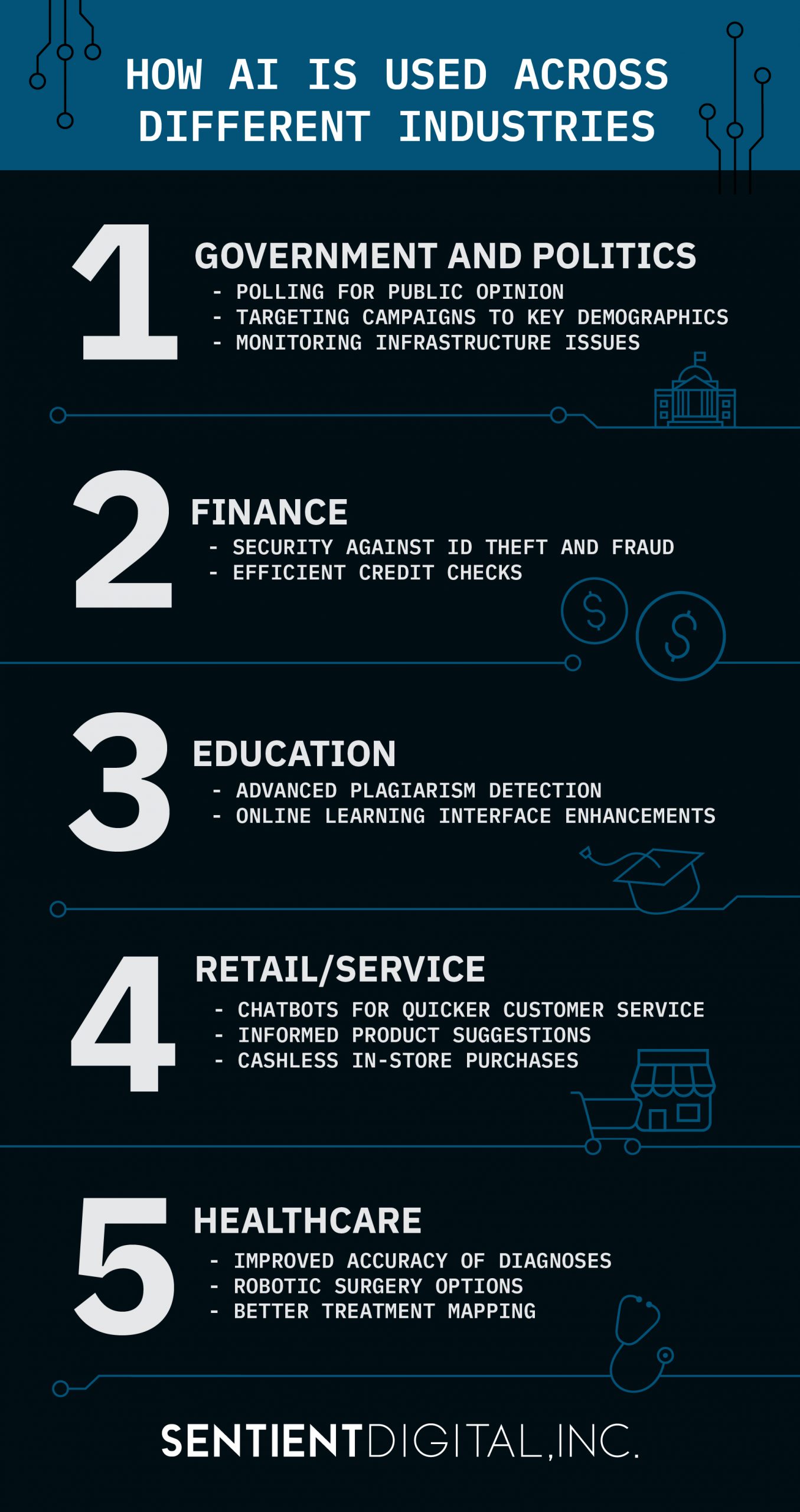The popularity of no code AI and low code AI is rising as organizations seek technological solutions to maximize their efficiency. No code and low code platforms offer a range of benefits to the companies that adopt them, while also serving to propel the industries involved in AI development forward.
Aside from all of the clear advantages of no code and low code AI platforms, there are a few limitations that businesses should be aware of when deciding if and how they want to use them. Regardless of these possible drawbacks, however, no code AI and low code AI development platforms present organizations across industry lines with opportunities to exceed and expand expectations as they offer their customers enhanced experiences.
Even with wider availability of less complex options like no code and low code AI, navigating artificial intelligence can be difficult. As a technology service provider specializing in AI, Sentient Digital is well-equipped to offer guidance on choosing appropriate no code and low code AI solutions, as well as handle more complex AI projects for our clients that require coding. We spoke with Gene Locklear, our Artificial Intelligence Research Scientist, to gain his insights on using no code and low code AI.
What Are No Code and Low Code AI?
To understand the value of no code AI and low code AI, organizations must have a general understanding of AI itself. Artificial intelligence (AI) is technology that allows computers to respond to stimuli in real time, in an organic way that mimics the processing of a human mind.
Some examples of common AI interactions that many of us engage in every day include speaking with smart assistants (such as Siri, Google Home, and Alexa), as well as using automatic smart replies in email and text conversations. The most common instance of AI in people’s daily lives may be Google’s predictive search algorithms, which can guess with great accuracy what you may be trying to look up.

No code and low code AI make the utility of artificial intelligence accessible to organizations on a larger scale. The difference between no code AI and low code AI is that the latter requires minimal programming by the user, while the former requires no programming on the user’s part at all. Because creating usable AI is such a complex process, many businesses are otherwise unable to capitalize on it without having highly skilled and experienced data scientists on staff. Even then, it can take years and untold funds to develop AI from scratch.
No code and low code AI platforms allow organizations to use pre-trained, easy-to-use AI packages that can be customized (within limits) to suit the needs of their company. While no code and low code tools are typically used for web and app development, they can also be used to build machine learning (ML) models.
According to Locklear, no code AI may come in handy for a start-up business that is seeking to offer a simple, effective solution, but lacks scientific know-how to do so. Low code AI, on the other hand, may be useful for a business that has an informed, scientific-based approach to the platform they want to use, but needs help when it comes to building or engineering the system itself.
By lowering the barriers of cost and complexity surrounding AI, no code AI and low code AI development platforms grant access to institutions that need the power of AI to better serve their customers, but don’t necessarily have the resources to create it. These pre-built platforms enable organizations that are not technology-focused to more efficiently provide their customers with the services they need, without having to worry about training employees in an entirely new set of complex skills.
The Benefits of No Code AI and Low Code AI for Business
Sound Recognition and Image Classification
A significant benefit that no code and low code AI platforms present to businesses is speeding up the AI adoption process, Locklear points out. Firstly, when building your AI solution, you can skip numerous steps in that process when you have access to a pre-built, pre-trained program designed to do almost specifically what you need.
These models of AI are mostly artificial neural networks (ANN), which have amazing abilities and impressive versatility. Neural networks have two main capabilities right now:
- The ability to recognize sounds
- The ability to classify images and detect objects within them
This may seem limited, but these two broad functions enable no code AI and low code AI platforms to be universal, giving them the ability to optimize processes in a wide range of organizations. These AI models could identify where objects are in a photo or recognize the layout of a room. These abilities could be useful for running digital interior design services or helping customers of a furniture company see how certain pieces fit into their space before buying them. They could also be used for more complex purposes, such as identifying which customers are most likely to be approved for a loan.
 Pre-Trained Programs
Pre-Trained Programs
No code AI and low code AI platforms provide users with increased speed in another way, in that not only do they come pre-built, but they can also arrive pre-trained to provide the exact solution the organization needs. This ability to be pre-trained is one of the most attractive aspects of no code and low code AI platforms.
The idea behind AI for business is creating something that can automate a process we seek to use in our work or make predictions that will save time and labor. The wonder of ANNs is that they are universal function approximators. This means that even when there is a need for a complicated process, like identifying a good mortgage applicant or a high-risk investment, the ANN will be able to reach the necessary function or formula to do that using the data that has been input. This process of inputting data and using that data to approximate a function is known as “training the model.”
The main issue when it comes to training the model is finding out what the source of the data for input will be. Now, however, many low code AI models are already trained and ready to use right out of the box. For organizations that cannot train models themselves for whatever reason—whether it’s a lack of available data or due to data that is formatted in an incompatible manner—this out-of-the box readiness is a game changer.
What’s On the Horizon for No Code and Low Code AI?

No code AI and low code AI democratize the availability of AI technology, Locklear explains, giving more companies meaningful access to it. In turn, as more organizations begin to integrate AI into their daily processes, we are likely to see highly optimized, more uniform interchanges between these businesses and their customers.
AI models can take over tasks that currently require heavily experienced human experts. Humans can be properly trained in a variety of unique ways that will impact their methodology. In the inevitable event of turnover, a company may struggle to train one employee to replace another. AI, on the other hand, presents companies with explainable methodology that they can replicate at will, with the added bonus that AI doesn’t leave.
This large spread of automation has caused some to believe that the future for data scientists is bleak as they sell the goose that lays the golden egg—their expertise. The concern is that if businesses begin to drag-and-drop to meet their AI needs, they do not need to employ data scientists to create these applications. The extension of AI through low code and no code models, however, will not lead to the extinction of the data scientist profession, but rather to its evolution.
Because of the engineering and coding expertise required to create and manage complex AI programs, it is highly unlikely that there will ever be a time when human input is not necessary for this process. Additionally, many organizations that adopt no code AI and especially low code AI options into their operations will still rely on data experts to help navigate and maintain the technology over time. As is the case with many industries, the realm of AI development is constantly changing, and the roles of experts in the field will change along with it.
Potential Limitations of No Code and Low Code AI
The benefits of no code and low code AI platforms are many, but there are a few potential limitations that organizations hoping to implement these models should keep in mind.
1. Choosing the Correct Model May be Tricky
Locklear warns that businesses are vulnerable to adopting a model that appears to work, but in reality is not actually getting them the result they need. A problem may have parameters inside of which an AI model will be expected to produce a reasonable prediction or solution. But the process to determine which model to use and how to use it is often beyond the ability of business owners that rely on low code AI platforms.
In some cases, a formula can be run a number of times before a user realizes it is not actually providing the answer they need. In this instance, the expertise of the IT provider should come into play. It is important to evaluate the skills and abilities of the provider you choose to work with if your company does not employ an experienced data scientist itself.
2. Using No Code and Low Code AI Can Impact a Project’s Life Cycle and Extendability
Locklear also points out that no code and low code AI models are designed to do a stated number of things. They often include limited drag-and-drop interfaces that do not allow projects built using them to be extended easily.
So, while these models can be reconfigured to involve additional parameters, this can undermine the business’ optimization efforts as such additions can lead to unstable predictions. When this happens, the service provider will have to be called in to solve the problem through redesign.
If you want to change service providers, this will most likely mean starting the project from scratch, as many AI services are not intercompatible.
3. Security Concerns May Arise When Using No Code and Low Code AI

When an organization uses an AI service provider, that provider may have complete and total access to that company’s data. Locklear stresses that this means choosing a trustworthy provider is critical when it comes to handling security while using AI in your business operations. If the provider you choose has security issues, you will too, so businesses must do their due diligence before committing to a provider.
Contact Sentient Digital for Your Complex AI Projects
When utilized correctly, AI can help your organization reach new heights at unbelievable speeds, but not all AI challenges can be addressed without the use of code. Fortunately, at Sentient Digital, we have experts like Gene Locklear on staff who possess the technical training and experience to handle more complex AI projects that do require code.
If you’re looking to capitalize on the optimization that artificial intelligence provides, contact Sentient Digital to get started with AI for your organization.



